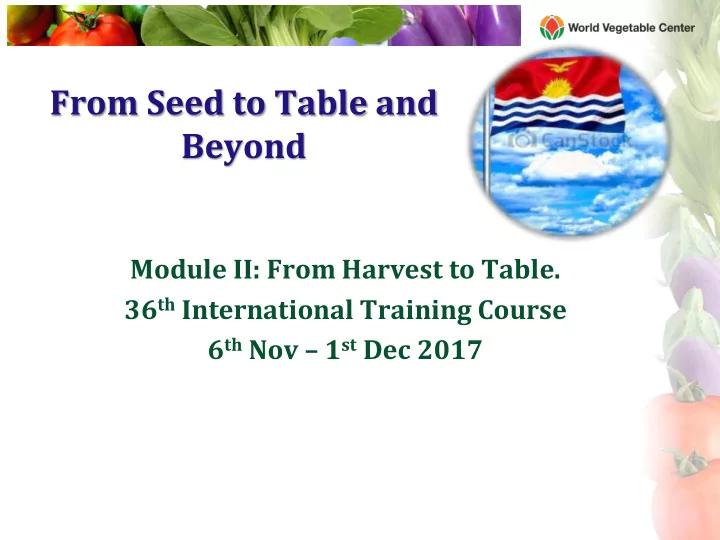

From Seed to Table and Beyond Module II: From Harvest to Table. 36 th International Training Course 6 th Nov – 1 st Dec 2017
Background information • Became independence in 1979 • 33 low-lying atolls • Average temperature is 33 degree Celsius • Main export is copra and fish
Bio Data • Tiaeke. Tanako • Agricultural Assistant. • Department of Agriculture and Livestock Division. • Ministry of Environments, Lands & Agriculture Developments. • Responsibility • implement agricultural activities approved by Head Office • conduct trainings and awareness program on agricultural activities • assist in the implementing and monitoring of community projects which are coordinated by ALD • act efficiently and effectively to any emerging issues that may hamper crops' and animals' lives and the community as a whole
Contn.
Agriculture (MELAD) strategic plan • Vision ‘ Kiribati to be a resilient nation to both natural and economic risks ’. • Mission ‘ MELAD in collaboration with all stakeholders to work for achieving a safe and healthy environment that is resilient to the impacts of global climate change and supports livelihoods, human health and sustainable development.
Agriculture and Livestock Division (ALD): Goals, Objectives • The goal of ALD is that “Household of Kiribati has food, income and nutrition security and the balance of agricultural and forestry environment is sustained and maintained The ALD will focus on four key objectives for the period 2016 - 2019: • Objective 1: Sustainable atoll crop production systems developed and promoted • Objective 2: Sustainable small animal livestock systems developed and promoted • Objective 3: Improved biosecurity • Objective 4: Capacity building for stakeholders and agricultural staff
Agriculture & Livestock Division • Livestock and Animal Welfare • Crop and Research Development • Biosecurity and Plant Health Services • Information, Training and Extension
• Three topic I found most useful and relevant to my Country are; • Nutrition, Post Harvest and Packaging.
Topic • Post Harvest Biology, Storage(Pre Cooling) and Nutritive Values of Local Produces.
Objectives • To maintain the Nutritional Values of Vegetables by designing simple method like hydro cooling method to lower the temperature before it package and stored properly. • To maintain the quality (nutritional values) of locally harvested fruits and vegetables to improved the diet of I Kiribati people through the development and promotion of a simple hydro cooling system. • To increases consumption of fruits and vegetables by enhancing both quality and health.
Problems. • Lack of Capacity on Post Harvest biology and package design which lead to nonnutritive of vegetables product for Human Consumption. • Vegetables have no proper storage to maintain their freshness and quality. • Consumers have no knowledge on home cooking conditions. • Vegetables are easily contaminated. • No packing shed • Lack of Sanitary Facilities
Contn.
Target Audience / Beneficiaries. • Local Farmers. • Consumers. • Public.
Activities to solve the Problems/Approach • Promote simple method for maintaining the temperature of the vegetables before the consumer buy. • Conduct a training on how to prevent flavor and texture of the fruit or vegetables after harvesting or buying in the market. • Designing a proper storage of commodities after it was cool down. • Encourage consumers of not overcooked fruit and vegetables.
Partnership • Departments of Agriculture & Livestock Division. • Departments of Health and Nutrition. • NGOs.
Work plan 2 yrs plan Activity Cost(AUD) Total Cost(AUD) No Performance Donor Maintain the nutritional J F M A M J J A S O N D of indicator day s 1.1Baseline survey to No of x x x 3 $60.00 $60.00 determine the status of value market (fuel- chain in Kiribati Surveyed $20.00/day) (20) Training of trainers program No of TOT x x x 3 $180.00 $7,200.00 on simple hydro cooling and trained ($20x3x3)40 simple post harvest practices (40) undertaken
Output 1. Maintain the J F M A M J J A S O N D No Performan D Cost Total cost days ce o nutritional values of indicator n Vegetables o r 1.2 Awareness campaign No of x x x x x G $100.0 $500.00 Radio develop to promote post o 0 programs harvest practices and the aired (5) K use of simple hydro cooling method. 1.3 Monitor and Evaluate No. of x x G $40.00 $80.00 market the effectiveness of the ($20.00 o adopted program fuel) the K practice. Total cost for 2 years $15,680.00
Expected Result • Enhancing the availability of nutrient in vegetables. • People will eat more nutritive and safe vegetables from pathogens and others microbes. • Minimized the malnutrition in Kiribati.
Thanks IVTC Members and major sponsored AVRDC Special thanks to Somchit (Oi) her Team for their great SUPPORT to US.
Recommend
More recommend